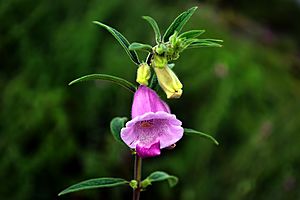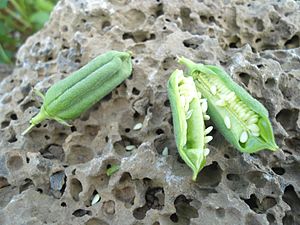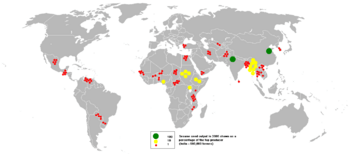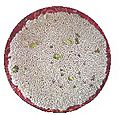Sesame facts for kids
Quick facts for kids Sesame |
|
|---|---|
 |
|
| Sesame plants | |
| Scientific classification | |
| Kingdom: | |
| Division: | |
| Class: | |
| Order: | |
| Family: | |
| Genus: | |
| Species: |
S. indicum
|
| Binomial name | |
| Sesamum indicum |
|
Sesame (Sesamum indicum) is a flowering plant known for its tasty seeds. It is also sometimes called benne. This plant grows in warm, tropical parts of the world. People grow sesame for its small, edible seeds, which grow inside pods.
Sesame seeds are one of the oldest oilseed crops. Humans started growing them over 3,000 years ago! Many wild types of sesame plants grow in Africa. The type we grow for food, S. indicum, first came from India. It's a tough plant that can grow even when there's not much water.
Sesame seeds have a lot of oil, more than most other seeds. They have a rich, nutty flavor and are used in cooking all over the world. Just like other nuts, some people can have allergic reactions to sesame.
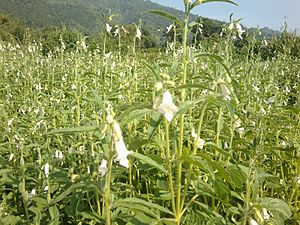
Sometimes, sesame seeds are sold without their outer shell. These are often sprinkled on top of baked goods like bread.
Contents
Where Did Sesame Come From?
Sesame seeds are thought to be the very first oilseed crop grown by people. Most wild types of the sesame plant come from Africa. But the kind we eat, S. indicum, started in India.
Scientists have found old sesame remains in India from about 5,500 years ago. This suggests that people first started growing sesame there. Some historians believe that sesame was traded between India and a place called Mesopotamia around 2000 BC.
Sesame was also grown in ancient Egypt. The Egyptians called it sesemt. It was even listed as a medicine in an old scroll called the Ebers Papyrus, which is over 3,600 years old. In Turkey, people were pressing sesame to make oil at least 2,750 years ago.
Sesame became popular because it could grow in places where other crops couldn't. It's a strong plant that doesn't need much help from farmers. It can grow in dry weather, hot temperatures, or even when there's too much rain. This made it a great crop for farmers living near deserts.
How Sesame Plants Grow
Sesame is an annual plant, meaning it lives for one growing season. It usually grows about 50 to 100 centimeters (about 1.5 to 3 feet) tall. Its leaves are long and narrow.
The flowers are white and shaped like a tube. They can be 3 to 5 centimeters (about 1 to 2 inches) long. Sometimes, the flowers can also be blue or purple.
Sesame seeds come in many different colors. The most common color sold is off-white. Other colors include tan, brown, gold, red, gray, and black.
The sesame fruit is a capsule, which is like a small pod. It's usually rectangular and has grooves. This capsule holds the seeds. It can be 2 to 8 centimeters long. When the seeds are ready, the capsule naturally splits open to release them.
Sesame seeds are small. Their size can vary, but they are usually about 3 to 4 millimeters long. They are oval-shaped and a bit flat. Each seed weighs about 20 to 40 milligrams.
Growing Sesame
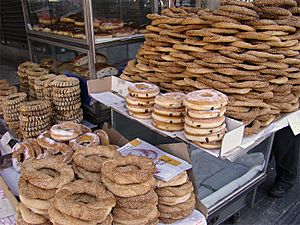
Sesame plants can grow in many different types of soil. But they grow best in rich, well-drained soil. They don't like soil with a lot of salt or too much water.
For a good harvest, sesame needs 90 to 120 days without frost. Warm weather, above 23°C (73°F), helps the plants grow well and produce more seeds. Even though sesame can grow in poor soil, it yields more when farms use proper fertilizers.
The amount of daylight affects when sesame flowers bloom. More daylight can also increase the amount of oil in the seeds.
Sesame plants are good at handling dry conditions because they have deep roots. However, they need enough moisture when they are first sprouting and growing. If there's too much or too little water, the plants will still survive, but they won't produce as many seeds.
Most types of sesame grown for sale don't like too much water. If it rains a lot late in the season, the plants keep growing. This can cause the seed pods to shatter and scatter the seeds before harvest. Strong winds can also cause this problem.
How Sesame Seeds Are Processed
Sesame seeds are protected by a capsule that only opens when the seeds are fully ripe. Since they don't all ripen at the same time, farmers often cut the plants by hand. They then stand them upright so all the capsules can finish ripening and open.
It's hard to dry sesame seeds after harvest because they are so small and flat. Air can't move around them easily. So, the seeds need to be harvested as dry as possible. They are stored with very little moisture to prevent them from heating up and going bad.
After harvesting, the seeds are usually cleaned. Then, their outer shells are removed. In some places, machines sort the seeds by color. This makes sure all the seeds look perfect, which customers often prefer.
Any seeds that are not fully grown or are the wrong size are removed. These are often used to make sesame oil.
Cooking with Sesame
Sesame seeds are a popular ingredient in many different foods. They are used whole in cooking because of their rich, nutty flavor. You can find sesame seeds on breads like bagels and hamburger buns. They are also baked into crackers and sesame sticks.
Many fast-food restaurants use buns with sesame seeds on top. For example, a lot of the sesame grown in Mexico is bought by McDonald's for their buns around the world.
In Asia, sesame seeds are sprinkled on some sushi dishes. In Japan, whole seeds are used in salads and snacks. Roasted tan and black sesame seeds are used to make a seasoning called gomashio. In East Asian cooking, like Chinese cuisine, sesame seeds and oil are used in dishes such as dim sum and sesame seed balls. Sesame flavor is also very popular in Korean cuisine, used to marinate meat and vegetables.
In Africa, sesame is called simsim. In Togo, the seeds are a main ingredient in soup. In other parts of Africa, ground sesame is used in a dish called wangila, often served with smoked fish.
Sesame seeds and oil are used a lot in India. In many parts of the country, sesame seeds are mixed with heated jaggery (a type of sugar) to make sweet balls or bars. These are eaten as snacks. In some regions, black sesame seeds are used to make special sweets and dishes with meat.
In Tamil Nadu, a state in India, sesame oil is widely used in cooking. A spicy powder called milagai podi, made from sesame and chili, is used to add flavor to traditional foods. Sesame oil is also used there to preserve food and to balance the heat of spicy dishes.
Sesame seed cookies are popular in places like Charleston, South Carolina. It's believed that West African slaves brought sesame, also called benne, to America in the 1600s. Since then, it has become part of American cooking.
In Caribbean cuisine, sugar and white sesame seeds are mixed to make a bar similar to peanut brittle.
Sesame is a very important ingredient in many Middle Eastern foods. Sesame seeds are made into a paste called tahini. This paste is used in dishes like hummus bi tahini and a sweet treat called halvah. Ground sesame is also part of za'atar, a popular spice mix in the Middle East.
In South Asian and Middle Eastern cooking, popular sweets are made from sesame mixed with honey or syrup. These are roasted to make sesame candy. In Japanese cuisine, goma-dofu is made from sesame paste and starch.
Mexican cuisine calls sesame seeds ajonjolí. It's mainly used in sauces like mole or adobo. It's also sprinkled on artisan breads and baked into traditional snacks.
In Sicilian cuisine, "Italian sesame seed cookies" are known as giuggiuleni. A giurgiulena is a nougat-like candy, often made for Christmas. Both words are different ways to say "sesame seed" in the Sicilian language.
Sesame oil is used for cooking in different parts of the world. The "toasted" form of the oil has a special, pleasant smell and taste. It's used as a condiment in some regions, especially in East Asia. Toasted sesame oil is also added to soups and other hot dishes just before serving to keep its strong flavor.
Gallery
Images for kids
See also
 In Spanish: Sésamo para niños
In Spanish: Sésamo para niños


